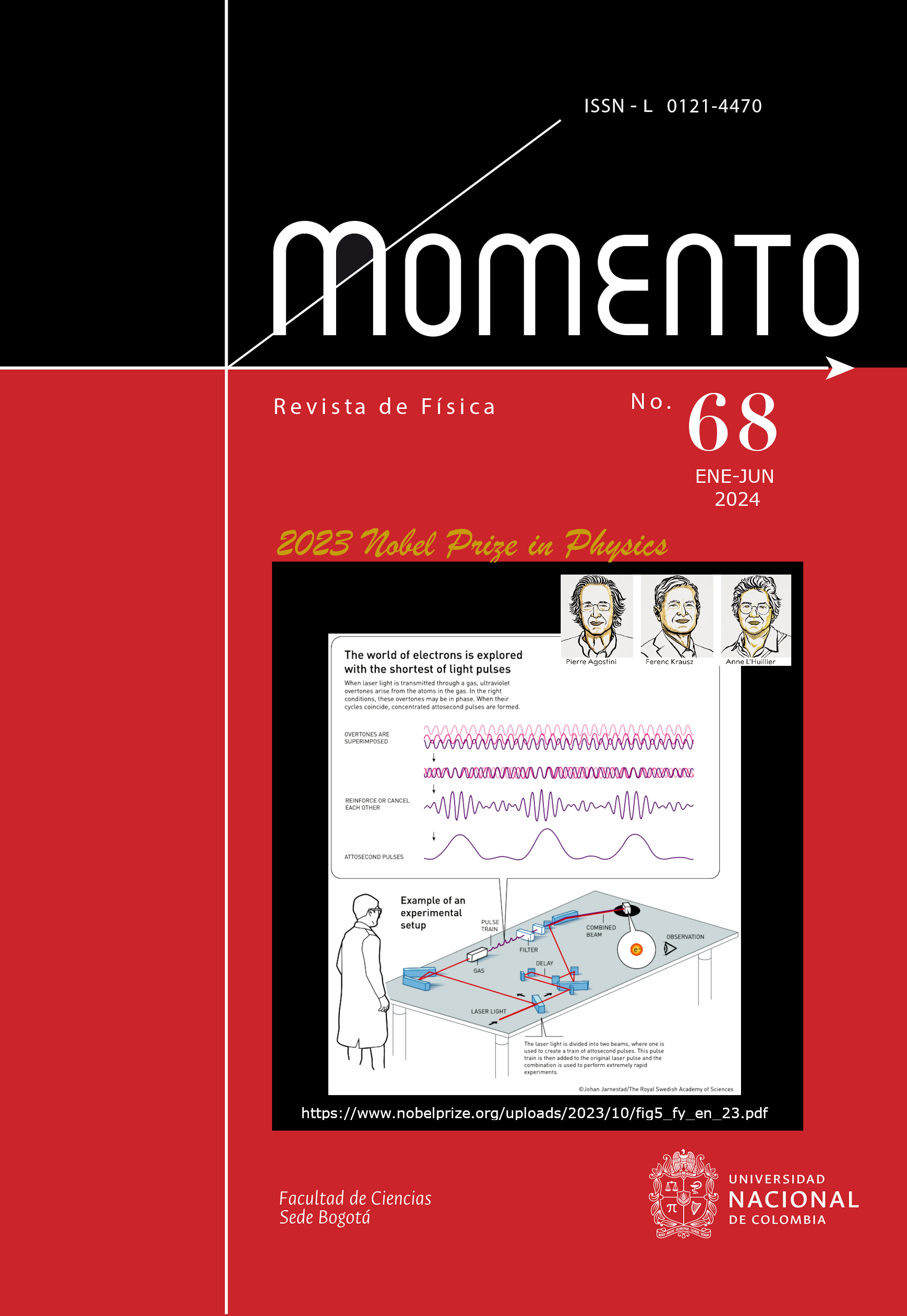SYNTHESIS AND CHARACTERIZATION OF CdS/CuAlO2/ITO NANO HETEREOSTRUCTURE NOVEL LED FOR OPTOELECTRONIC APPLICATIONS
SÍNTESIS Y CARACTERIZACIÓN DE LA NANOHETEROESTRUCTURA CdS/CuAlO2/ITO: UN NUEVO LED PARA APLICACIONES OPTOELECTRÓNICAS
DOI:
https://doi.org/10.15446/mo.n68.110999Keywords:
delafossite, heterostructure, nanoparticles, light emitting diodes, optoelectronics, cadmium sulphide (en)delafosita, heteroestructura, diodos emisores de luz, nanopartículas, optoelectrónica, sulfuro de cadmio (es)
Downloads
Nano-heterostructures (NHs) are drawing attention due to their fascinating properties as materials for constructing nano-electronic devices. CdS and CuAlO2 were prepared using the co-precipitation method and deposited, respectively, on Indium Tin Oxide (ITO) substrate to study their characteristics and effectiveness for light-emitting diode (LED) applications and photodetectors. Investigations were made on the morphological, optical, and electrical characteristics. According to the X-ray diffraction pattern, CdS nanoparticles have a cubic phase structure and diffraction peaks at 26.3◦, 43.8◦, and 51.8◦. UV-visible optical studies were used to characterize the absorbance of CdS, CuAlO2, and CdS/CuAlO2/ITO with redshift around 400 nm for the nanoparticles. Using the Tauc plot, the band gap energy of the prepared heterostructure showed a value of 3.1
eV. The Scanning Electron Microscopy (FESEM) images show homogeneous morphology with little agglomeration. I-V characterization reveals good properties with high forward current power. CdS/CuAlO2/ITO shows high responsivity of 0.45 A/W, which indicates a straightforward, low-cost, and effective fabrication technique for the fabrication of light-emitting diodes and a promising heterostructure for manufacturing photo detectors.
Las nano heteroestructuras (NH) están llamando la atención debido a sus fascinantes propiedades como materiales para la construcción de dispositivos nanoelectrónicos. El CdS y el CuAlO2 se prepararon mediante el método de coprecipitación y se depositaron, respectivamente, sobre sustrato de óxido de indio y estaño (ITO) para estudiar sus características y efectividad en aplicaciones de diodos emisores de luz (LED) y fotodetectores. Se investigaron las características morfológicas, ópticas y eléctricas. De acuerdo con el patrón de difracción de rayos X, las nanopartículas de CdS tienen una estructura de fase cúbica y picos de difracción a 26.3◦, 43.8◦, y 51.8◦. Se utilizaron estudios ópticos UV-visibles para caracterizar la absorbancia de CdS, CuAlO2, y CdS/CuAlO2/ITO con un desplazamiento al rojo de alrededor de 400 nm para las nanopartículas. Utilizando la gráfica de Tauc, la energía de banda prohibida de la heteroestructura preparada mostró un valor de 3.1 eV. Las imágenes de Microscopía Electrónica de Barrido (FESEM) muestran una morfología homogénea con poca aglomeración. La caracterización I-V revela buenas propiedades con una alta potencia de corriente directa. El CdS/CuAlO2/ITO muestra una alta respuesta de 0.45 A/W, lo que supone una técnica de fabricación sencilla, económica y eficaz para la fabricación de diodos emisores de luz y una heteroestructura prometedora para la fabricación de fotodetectores.
References
K. Saumya, S. Naskar, and T. Mukhopadhyay, Nano Futures 7, 032005 (2023). https://doi.org/10.1088/2399-1984/acf0a9
Q. Qian, Z. Wan, and X. Duan, National Science Open 2 (2023). https://nso-journal.org/articles/nso/pdf/2023/01/NSO20220040.pdf DOI: https://doi.org/10.1360/nso/20220034
H. Inaya and M. Mahdi, Iraqi J. Phys. 21, 92 (2023). https://doi.org/10.30723/ijp.v21i3.1126
M. Almamari, N. Ahmed, and et al., Heliyon 8, e09959 (2022). https://doi.org/10.1016/j.heliyon.2022.e09959
N. Hullavarad and S. Hullavarad, Photonic. Nanostruct. 5, 156 (2007). https://doi.org/https://doi.org/10.1016/j.photonics.2007.03.001
I. Ismail, K. Khashan, and A. Alwaan, Silicon 9, 321 (2017). https://doi.org/https://doi.org/10.1007/s12633-016-9446-4
I. Hadi, K. Khashan, and D. Sulaiman, Mater. Today-Proc. 42, 3054 (2021). https://doi.org/https://doi.org/10.1016/j.matpr.2020.12.828
C. Martínez, C. Rodríguez, and et al., Int. J. Photoenergy 2014, 453747 (2014). https://doi.org/https://doi.org/10.1155/2014/453747
A. Samadi and M. Sadeghi, Spectrochim. Acta A 152, 156 (2016). https://doi.org/https://doi.org/10.1016/j.saa.2015.07.052
S. Talwatkar, Y. Tamgadge, and et al., Solid State Sci. 38, 42 (2014). https://doi.org/https://doi.org/10.1016/j.solidstatesciences.2014.09.014
M. Abd, H. Wasly, and K. Batoo, Appl. Phys. A 125, 283 (2019). https://doi.org/https://doi.org/10.1007/s00339-019-2576-y
M. Shariati, A. Samadi, and A. Colagar, J. Hazard. Mater. 366, 475 (2019). https://doi.org/https://doi.org/10.1016/j.jhazmat.2018.12.025
T. Park, K. Lee, and S. Lee, Appl. Microbiol. Biotechnol. 100, 521 (2016). https://doi.org/10.1007/s00253-015-6904-7
N. Hullavarad and S. Hullavarad, Photonic. Nanostruct. 5, 156 (2007). https://doi.org/10.1016/j.photonics.2007.03.001
H. Kawazoe, M. Yasukawa, and et al., Nature 389, 939 (1997). https://doi.org/10.1038/40087
L. Cattin, B. Reguig, and et al., App. Surf. Sci. 254, 5814 (2008). https://doi.org/10.1016/j.apsusc.2008.03.071
O. Rabinovich, S. Legotin, and et al., Jpn. J. Appl. Phys. 55, 05FJ13 (2016). https://doi.org/10.7567/JJAP.55.05FJ13
T. Ehara and T. Nakanishi, MATEC Web Conf. 67, 04012 (2016). https://doi.org/10.1051/matecconf/20166704012
Z. Abdul, Adv. Nat. Appl. Sci. 10, 72 (2016). https://www.researchgate.net/profile/Zehraa-Najim/publication/331233792_ADVANCES_in_NATURAL_and_APPLIED_SCIENCES_Open_Access_Journal_Effect_of_Concentration_on_Characterization_of_MgO_Nanoparticles_using_Chemical_Bath_Method/links/5c6da1d2299bf1e3a5b8bfa0/ADVANCES-in-NATURAL-and-APPLIED-SCIENCES-Open-Access-Journal-Effect-of-Concentration-on-Characterization-of-MgO-Nanoparticles-using-Chemical-Bath-Method.pdf
Z. Abdul, J. Compos. Adv. Mater. (RCAM) 31, 167 (2021). https://doi.org/10.18280/rcma.310308
C. Bouzidi, H. Bouzouita, and et al., Mat. Sci. Eng. B 118, 259 (2005). https://doi.org/10.1016/j.mseb.2004.12.039
M. Maleki, S. M., and et al., Semicond. Phys. Quantum Electron. Optoelectron. 10, 30 (2007). https://doi.org/10.15407/spqeo10.01.030
J. Pellicer, A. Segura, and et al., Appl. Phys. Lett. 88, 181904 (2006). https://doi.org/10.1063/1.2200398
H. Kawazoe, M. Yasukawa, and et al., Nature 389, 939 (1997). https://doi.org/10.1038/40087
How to Cite
APA
ACM
ACS
ABNT
Chicago
Harvard
IEEE
MLA
Turabian
Vancouver
Download Citation
CrossRef Cited-by
1. Zehraa N. Abdul-Ameer. (2025). STUDYING ZINC OXIDE/COPPER OXIDE/CADMIUM SELENIDE NANOSTRUCTURES FOR LIGHT EMITTING DIODES. MOMENTO, (70), p.33. https://doi.org/10.15446/mo.n70.114898.
2. Zehraa Najim Abdul-Ameer. (2024). Investigation optical and structural characterization for WO3/CuO/ITO nano hetreostructure for optoelectronic devices. Journal of Optics, https://doi.org/10.1007/s12596-024-02378-9.
Dimensions
PlumX
Article abstract page views
Downloads
License

This work is licensed under a Creative Commons Attribution-NoDerivatives 4.0 International License.
Those authors who have publications with this journal, accept the following terms:
a. The authors will retain their copyright and will guarantee the publication of the first publication of their work, which will be subject to the Attribution-SinDerivar 4.0 International Creative Commons Attribution License that permits redistribution, commercial or non-commercial, As long as the Work circulates intact and unchanged, where it indicates its author and its first publication in this magazine.
b. Authors are encouraged to disseminate their work through the Internet (eg in institutional telematic files or on their website) before and during the sending process, which can produce interesting exchanges and increase appointments of the published work.




















